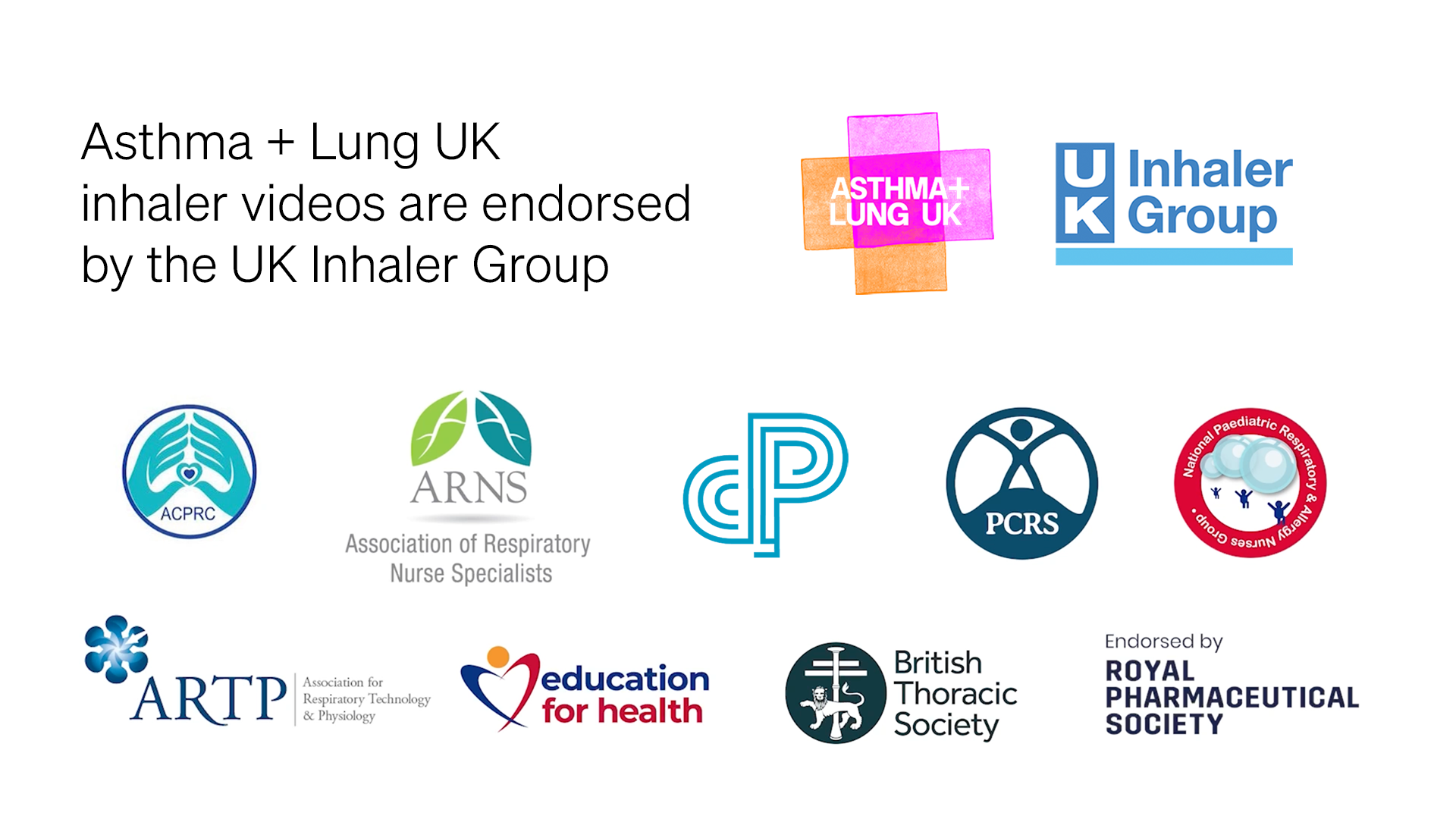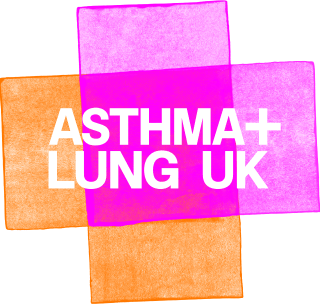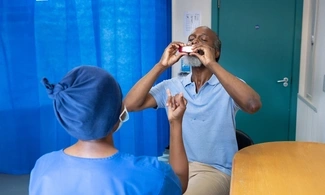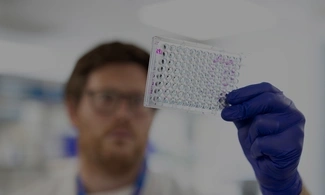In this short video, we show you how to help your child use a spacer without a face mask using the tidal or multiple breathing technique. We have a different video if you’re helping a child use a spacer without a face mask.
Your child may need to use a spacer with a face mask until they’re ready to use a spacer with a mouthpiece.
The spacer and face mask will help your child get the full dose of medicine. Using a spacer can also prevent side effects from steroid medicines in preventer or combination inhalers.

Expert advice for using a spacer with a face mask for a baby or child
Hi I'm Caroline. I'm a specialist respiratory nurse.
Using a spacer and face mask when you're giving a baby or child medicine from an inhaler means more of the medicine gets down into their lungs and is a great way to help manage their symptoms.
Getting the technique right is very important. It may take a few tries to feel comfortable giving medicine this way, but it does get easier with practice.
I'm going to show you how to use a spacer with a face mask for a baby or child.
If you're an adult using a spacer with a face mask, watch our video for adults.
When using an inhaler and spacer with a face mask for a baby or child, how you hold or sit with your child will depend on their age.
If you have a baby or young toddler, sit them on your lap facing you so you can keep eye contact.
With very young babies, some parents find it works best to tilt them back slightly.
If your child is older, you can sit them on your lap either sideways or facing away from you, as it's easier to handle the inhaler and spacer.
If they prefer to sit or stand by themselves, it works best to face them.
1. First, hold the inhaler upright and take the cap off.
2. Check there's nothing inside the mouthpiece.
3. Shake the inhaler well [you can leave the inhaler in the spacer while you shake it].
4. Put the inhaler into the hole at the back of the spacer with the indent for the nose on the mask facing upwards.
5. Ask your child to sit or stand up straight and slightly tilt their chin up, as it helps the medicine reach their lungs.
6. Put the mask on their face to make a seal over their nose and mouth.
The next steps all happen smoothly in one action.
7. Encourage your child to breathe in and out [through their mouth].
8. Press the canister on the inhaler once and get them to breathe in and out slowly and steadily [through their mouth] five times.
9. Remove the mask from their face.
If your child is using a small volume spacer with the mask, some of them make a whistling sound if they are breathing in too fast.
If your baby is using a large volume spacer with the mask, you need to tilt the end of the inhaler up to open the valve.
The device should make a clicking sound as the valve opens and closes.
10. If your child needs to take another dose, remove the mask from their face. Wait 30 seconds to a minute and shake the inhaler again, then repeat steps (5 to 9).
11. When you've finished, take the inhaler out of the spacer and replace the cap.
If your child has used an inhaler that contains steroids, wipe your child's face with a damp cloth and rinse their mouth out with water or brush their teeth to avoid side effects.
Remember, you can get more top tips on helping your child use their inhaler by watching our other videos.
Call 999 if:
Your child is having an asthma attack or flare-up of their lung condition, and their reliever inhaler is not helping.
Check your child's inhaler technique
Helping your child use the right inhaler technique with their spacer will help them breathe the medicine straight into their lungs, where it’s needed.
This will help your child:
- manage their symptoms without needing to take a higher dose of their medicine
- reduce their risk of having an asthma attack or flare-up of their lung condition. The medical word for this is exacerbation.
- manage their usual triggers better
- reduce their side effects
- make their medicine last longer
- sleep better
- take part in exercise or other activities.
It’s important to watch your child take their inhaler so that you know they’re using it properly.
You can also ask your GP, nurse or pharmacist to check your child’s inhaler technique. Remember that you do not need an appointment to get help from a pharmacist at your local pharmacy.
Check that your child is using the right spacer or face mask
As your child grows, the size of their face mask or spacer may change. Using the right type of spacer can help your child get the full dose of their medicine.
If your child is over five years old, they should try using a spacer without a face mask. This is because the medicine can stick to your child’s face or the inside of the face mask.
But if your child cannot use a spacer without a face mask, there are masks available for older children and adults.
You can ask your child’s GP, nurse or pharmacist to check that they’re using the right spacer for their age and size.
Tips to help your child use their inhaler and spacer correctly
Some inhalers need to be shaken well before each use. This includes pressurised metered dose inhalers (pMDIs) and breath-actuated inhalers (BAIs). Four or five times is ideal.
This helps to make sure the medicine and the gas that create pressure in your child’s inhaler (called a propellant) mix properly.
If you’re not sure whether you need to shake your child’s inhaler, check the Patient Information Leaflet (PIL) that comes with their inhaler or speak to a healthcare professional.
Testing your child’s inhaler usually means checking if you can see medicine coming out without them inhaling it. It’s important to check that your child’s inhaler is working properly to make sure they get the right amount of medicine to their lungs.
You should test a pMDI inhaler if your child has not used it for a few days, or they're using a new one for the first time. You do not need to test your child’s inhaler before every use.
The Patient Information Leaflet (PIL) that comes with your child’s inhaler might also tell you how often you should test their inhaler. Ask a healthcare professional if you’re not sure or have any questions.
To check how to test your child’s inhaler, check the PIL or ask a healthcare professional. You might test the inhaler by taking the cap off, pointing the mouthpiece away from you and your child, and pressing the canister to release a puff into the air.
Help your child sit or stand up straight. If this is too difficult, sit your child on your lap, either sideways or facing away from you. If you have a baby or young toddler, you might like to sit them on your lap facing you so you can reassure them.
Help your child lift their chin slightly and hold the inhaler upright. This helps the medicine reach your child’s lungs, where it’s needed.
If your child uses a mask that fits their face properly, it will help them get the full dose of the medicine.
Before using their inhaler, your child should breathe out as far as they can through their mouth. This will create more space in their lungs.
They can then take a full breath in through their mouth when using their inhaler.
If your child can hold their breath for 10 seconds after using their inhaler, it will help the medicine to settle in their lungs. They should only hold their breath for as long as they feel comfortable.
Waiting between each puff gives the medicine and gas (called a propellant) enough time to mix back together after being shaken.
Some preventer inhalers and combination inhalers, like Maintenance and Reliever Therapy (MART) and anti-inflammatory reliever (AIR), contain steroid medicine.
The steroid medicine can build up on the back of your child's throat, mouth and tongue and cause side effects including:
- a hoarse voice
- cough
- sore throat
- a mouth infection called oral thrush.
If your child can rinse their mouth with water and spit it out after using their inhaler, it can help to clear the medicine. This can help reduce the chance of these side effects.
When using a face mask, the medicine can stick to your child’s face. Wiping your child’s mouth after they use their inhaler can help prevent a mouth infection.
Getting your child into a good medicine routine
It’s a good idea to support your child to get into a regular medicine routine.
They will need to take their preventer inhaler every day as prescribed, even if they’re feeling well. You should watch them to make sure they’re taking their medicines correctly.
Having a regular routine can help you and your child remember to use their inhaler and spacer. Learning this will help them manage their asthma more independently when they’re old enough and feel ready.
Try these top tips to help your child get into a good medicine routine:
- Keep their preventer inhaler and spacer or face mask on their bedside table to remind them to take it when they wake up and just before going to sleep.
- Make it fun so that your child links taking their inhaler with something positive. This can also help your child to feel more comfortable with taking their inhaler. Some parents have told us they find it helpful to decorate their child’s inhaler or spacer with stickers, give the inhaler a character name, do a special handshake or fist bump after each time they take it, or make doing a silly dance together part of the routine.
- Set yourself reminders on your phone or write yourself a note in your diary or in your calendar. This can be useful if you’re away from home too.
- Ask family or friends to help remind you and your child. This might be useful if your child has recently started using an asthma inhaler. If your child has siblings who are old enough to help, it’s a good idea to teach them about asthma too.
Help your child feel comfortable with their inhaler and spacer
We know from calls to our helpline that it can be difficult to get your child to use their inhaler and spacer. Using an inhaler and spacer might feel like a scary and unfamiliar experience for them. It’s normal that this can sometimes lead to emotional reactions.
It might take some time for your child to feel comfortable with taking their medicines, but it does get easier with practice.
If your child’s inhaler and spacer are still not working well for them, or they're not comfortable with their devices even after trying them for 8 to 12 weeks, talk to a healthcare professional.
If your child does not want to use their inhaler and spacer, you could try to reassure them by pretending to take the medicine yourself or pretending to give it to their favourite toy.
Helping your child get into a good medicine routine can also make them feel comfortable with their medicines.
Disclaimer
This video is not a replacement for professional medical advice. If you’re finding it hard to use your inhaler or you’re worried about your symptoms, please speak with a healthcare professional.
Your GP, nurse or pharmacist can check your inhaler technique. Remember that you do not need an appointment to get help from a pharmacist at your local pharmacy.
Always read the patient information leaflet inside your medicine packet. It tells you more about your medicine, including all the possible side effects and how to store the medicine safely. Speak to your GP, nurse or pharmacist if you have any questions.
Asthma + Lung UK does not endorse or recommend specific products. Read more about how we create our health advice information.


Get support
Call our helpline for support with your condition. Get advice on your medicines, symptoms or travelling with a lung condition, or just call us to say hello.
Find out more












